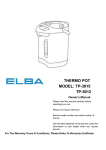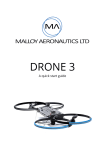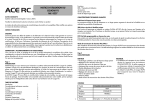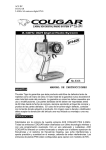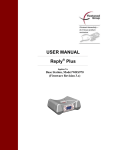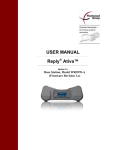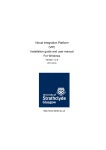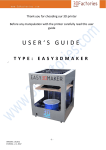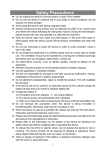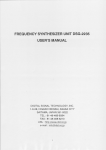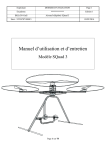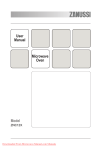Download Meknic Flydrone User Manual
Transcript
Meknic Flydrone User Manual 1| About this Guide Thank for purchasing Meknic Brand product. We made every effort to ensure that this User Guide is accurate and complete. Due to the unforeseen changes or product upgrades, the information contained in the manual is subject to change without notice. Please strictly follow this manual requirement to use your product. This manual shows you how to achieve flight by a simple operation, you can also download the electronic manual of the advanced version from the APM website to know the advanced flight function and more product characteristics, (for example: configuring parameters by connecting to assistant software, matching frequency between the transmitter and the receiver, etc.), for more flying fun. Notice: This product built-in autopilot system is APM, you can obtain the current APM firmware version to the assistant software; If you upgrade the firmware version by assistant software, you need to read the release record and guide that corresponds to the firmware version. 2| If you have any problem that cannot solve during installation, please contact official authorized dealer or customer service. Content Quality Statement........................................................................................................... Disclaim & Warning........................................................................................................ Trademarks.................................................................................................................... Cautions For Product Use.............................................................................................. Battery Usage & Charging Cautions............................................................................... In The Box...................................................................................................................... Introduction.................................................................................................................... Aircraft & Transmitter Basic Operation.......................................................................... Before Flying.................................................................................................................. Flying Test..................................................................................................................... Flowchart of Fail safe & How to Regain Control ........................................................... Low Voltage Alert.......................................................................................................... Use The Assistant Software.......................................................................................... 3| Aircraft Parameters....................................................................................................... FCC Statement This equipment has been tested and found to comply with the limits for a Class B digital device, pursuant to Part 15 of the FCC Rules. These limits are designed to provide reasonable protection against harmful interference in a residential installation. This equipment generates, uses and can radiate radio frequency energy and, if not installed and used in accordance with the instructions, may cause harmful interference to radio communications. However, there is no guarantee that interference will not occur in a particular installation. If this equipment does cause harmful interference to radio or television reception, which can be determined by turning the equipment off and on, the user is encouraged to try to correct the interference by one or more of the following measures: Reorient or relocate the receiving antenna. Increase the separation between the equipment and receiver. 4| Connect the equipment into an outlet on a circuit different from that to which the receiver is connected. Consult the dealer or an experienced radio/TV technician for help. This device complies with Part 15 of the FCC Rules. Operation is subject to the following two conditions: (1) This device may not cause harmful interference, and (2) this device must accept any interference received, including interference that may cause undesired operation. FCC Caution: Any changes or modifications not expressly approved by the party responsible for compliance could void the user's authority to operate this equipment. CE Regulatory Notice This equipment complies with the requirements set out in the Council Directives on the Approximation of the Laws of the Member States relating Electromagnetic Compatibility (2004/108/EC); the Low Voltage Directive (2006/95/EC); the Restriction of The Use of Certain Hazardous Substances in Electrical And 5| Electronic Equipment Directive (2002/95/EC), Turkish EEE Directive; the Commission Regulation (EC) No 1275/2008 implementing Directive 2005/32/EC of the European Parliament and of the Council with regard to eco-design requirements for standby and off mode electric power consumption of electrical and electronic household and office equipment, and the Directive 2009/125/EC of the European parliament and of the council establishing a framework for the setting of eco-design requirements for energy-related products. Disclaim & Warning Please read this disclaim carefully before using the product .by using this product ,you hereby agree to this disclaim and signify that you have read them fully .this product is not suitable for people under the age of 18. Meknic Flydrone is an excellent flight platform offering an excellent flight experience only it is powered normally and in a good working condition .Despite Meknic Flydrone having a built-in autopilot system and our effects in making the operation of the controller as safe as possible when the main power battery is connected ,we strongly recommend users to remove all propellers when calibrating and setting parameters make sure all connections are good ,and keep children and animals away during firmware upgrade .We Innovations accepts no liability for damages or injure incurred directly or indirectly from the use of this 6| Product in the following conditions : 1. Damages or injure incurred when users are drunk ,taking drugs drug anesthesia, dizziness, fatigue ,nausea and any other conditions no matter physically or mentally that could impair your ability . 2. Damages or injure caused by subjective intentional operations. 3. Any mental damage compensation caused by accident. 4. Failure to follow the guidance of the manual to assemble or operate. 5. Due to the fact that the operator cause the damage to the nature reserves or the relevant management units which is forbid in the flight area. 6. Malfunctions caused by refit or replacement without our accessories and parts. 7. Damages or injure caused by using third party products or fake products. 8. Damages or injure caused by wrong operation or subjective wrong judgment. 9. Damages or injure caused by mechanical failures due to erosion, aging. 10. Aircraft sends low voltage alert, still cannot land, causing the aircraft crash. 11.Damages or injure caused by knowing flying the aircraft in abnormal condition(such as water ,oil, soil, sand and other unknown material ingress into the aircraft or the assembly is not completed, the main components have obvious fault, obvious defect or missing accessories.) 12.Damages or injure caused by flying in the following situations such as the aircraft in Magnetic interference area, radio interference area, government regulated no fly zones or the pilot is in black light ,blocked fuzzy sight, and poor eyesight is not suitable for operating or other conditions not suitable for operating. 13.Damages or injure caused by using in bad weather ,such as a rainy day or 7| windy (more than moderate breeze,)snow, hail, lighting, tornadoes, hurricanes etc. 14. Damages or injure caused when the aircraft is in the following situations: collision, fire, explosion, floods, tsunamis, subsidence, ice trapped, avalanche, debris flow, landslide, earthquake, etc. 15. Damages or injure caused by infringement such as any data, audio, video material recorded by the use of aircraft. 16. Damages or injure caused by the misuse of the battery, protection circuit, RC model and battery chargers. 17. Equipment or parts cause any indirect loss or legal liability. 18. Failure to use the instruction to operate all flight. 19 .The operators do not obey the local laws, causing legal liability, personal property loss or damaging to the ecology. 20 .The operators do not complete enough flight training and conduct unsafe flying which cause the losses and legal liability. 21. The operator does not obey our official using method and various considerations which cause the losses and legal liability. 22. Other losses that are not covered by the scope of our company’s innovation liability. Trademarks Meknic is the registered trademarks of the innovations in USA and EU countries .Names of the product, brand, etc. appearing in this manual are trademarks or registered trademarks of their respective Daten Group Company. The product and manual are copyrighted by our innovations with all right 8| reserved .no part of this product or manual shall be reproduced in any form without the prior written consent or authorization of our innovations .no patent liability is assumed with respect to use of the product or information contained herein. Cautions for Product use Please check the following steps every time before flight 1. Before using this product, please accept some flight training. (for instance: using a simulator to practice flying, getting instruction from a professional person, etc.) 2. Check that all parts of the multi-rotor are in a good condition before flight, do not fly with aging or broken parts. 3. Check that the propellers and motor are installed correctly and firmly before flight .make sure the rotation direction of each propeller is correct. Do not close to or even touch the working motors and propellers to avoid serious injury. 4. Do not over load the multi-rotor (should be less than 1400g) 5. Try to Avoid Interfere between the remote control transmitter and other wireless 9| equipment. 6. Make sure that the transmitter battery and flight battery are fully charged. 7. Make sure to switch on the transmitter first, and then power on multi-rotor before takeoff! (power off the multi-rotor first, and then switch off the transmitter after landing) 8. The fast rotating propellers will cause serious damage or injury. Always fly the multi-rotor 3m or above away from you and unsafe conditions such as obstacles, crowds, high voltage lines, and so forth fly responsibly. 9. All parts must be kept out of the reach of children to avoid CHOKE HAZARD, if a child accidentally swallows any part you should immediately seek medical assistant. 10. Please always keep the compass module away from the magnet .otherwise it may damage the compass module and lead the aircraft to work abnormally or even be out of control. 10 | 11. Do not use the transmitter (receiver) with the third party remote control equipment. 12. Make sure to use the assistant software of 1.2 version (or above 1.2) to carry out firmware upgrade and parameter configuration .Do not use the assistant software below 1.2version. 13. The product built-in ESC only support 4s (14.8V) power supply, Do not use the battery of higher voltage. 14. Use the original motor and 10-inch Propeller, Do not use the other dimension propeller. 15. If you want to put the product in the car,please keep it away from the speaker since the compass module maybe magnetized. 16. Do not use the magnetic screwdriver, otherwise, keep the screwdriver at least 10cm away from the compass module to avoid the magnetic effect. 17.If you use your own camera equipment(for example GoPro),please make sure 11 | the WIFI function is disabled ,to avoid the interference on the transmitter ,which may cause the product to Fail safe, crack or even to fly away. 18. For Mac user, please install windows parallel to ruin assistant software. Battery usage and charging cautions Do not put the battery in the water, store the battery in a cool and dry environment. Only use the correctly specified batteries. 3. Batteries must be kept out of the reach of the children, if a child accidentally swallows the battery you should immediately seek the medical assistant. 4. Do not use or store the battery near the fire. 5. Battery should be charged with proper standard charger. 6. Do not connect the battery reversed in position and negative terminals in the charger or equipment. 7. Do not connect the battery directly to the walls plug or vehicle -mounted socket. 8. Do not put the battery into the fire or heat the battery. 12 | 9. Do not let the battery terminals touch together to cause short circuit. 10. Do not transport or store the battery and together with metal objects. 11. DO not hit or throw the battery. 12. Do not weld the battery terminals together. 13. Do not drive a nail in, hit with a hammer, or stomp on the battery. 14. Do not disassemble or alter the battery. 15. Do not use or store the battery in extreme heat environments, such as the direct sunlight or in the car. Otherwise the battery will overheat, may cause fire, this will affect the performance of battery, shorten the battery life. 16. Do not use the battery in the strong electrostatic areas, otherwise the electronic protection may be damaged which may cause a hazard. 17. If you get the battery electrolyte leakage into yours eyes. Do not rub, first wash your eyes with clean water then seek the medical assistant immediately. If not handled in a timely manner, eyes could be damaged. 18. Do not use the battery when it emits a peculiar smell, high temperature, 13 | deformation, change in color or other abnormal phenomenon, if the battery is in use or charging, you should stop the charging or using immediately. 19. If the battery terminals get dirty, please clean it with dry cloth before using .otherwise it will cause a poor contact, thus causing the energy loss or cannot charge. 20. Discarded battery lead to a fire, you should completely discharge the battery and wrap the output terminal with insulating tape before discarding. 21. Do not drain the battery of product or leave the battery plugged into the product when unused .when there is low voltage alert, please landing timely to avoid the damages to the battery or others. 14 | In the box Please check the package items before using. No. Name 1 Aircraft 1 2 2.4G RC 1 3 Landing Gear Diagram Qty. Instruction 1 15 | Each pairs including a 4 Propeller 2 positive and counter paddle, pay attention to the paddle direction 5 Assistant Wrench 1 6 LiPo Battery 1 The battery for aircraft 7 AA Battery 4 Battery for RC 8 9 10 Adapter Balance Charger Plug Adaptor 1 110-240V auto-adaptation power supply 1 Charge for lithium battery 3 CE, SAA, BS, optional 16 | 11 Micro USB Cable 1 12 Accessory 1 13 Screw 8 M2.5X20(6pcs) Introduction Meknic Fly drone is an all-in-one small Quad copter designed for multi-rotor enthusiasts. Before shipping from the factory, it has been configured and fully tested, which means you have no configuration to do. Aircraft 17 | [1] Propeller [2] Brushless Motor [3] Battery Cover [4] Landing Gear [5] Battery Power Indicator(Red) [6] GPS Signal Lights(Blue) [7] Tail Shield Piece 18 | [8] Nose Lights(Red) [9] Gimbal Fixed Hole [10] Gimbal Control Port(*) [11] Micro USB Port [12] Tail Light(Green) Gimbal Control Port(*),from the nose direction as follows:①+12V power output, ②Roll, ③Pitch, ④GND, ⑤GND, ⑥Null 19 | Aircraft Built-in APM Flight Control System Aircraft operating mode Stabilize Mode Barometer Altitude Hold GPS Module Loiter Mode Magnetic Module RTL Mode RC Receiver Fail-Safe Protection Flight Power System Low Voltage Protection Aircraft Indicator Remote control 20 | [1] Antenna [2] RTL Switch [3] Power Indicator [4] Signal Transmission Indicator [5] Left Stick(Throttle: up & down, Yaw: rotation) [6] Neck Strap Attachment [7] power switch 21 | [8] control mode switch [9] Right Stick(Roll: left & right, Pitch: front & back) [10] External Power Port [11] Handle [12] Battery Cover [13] Simulator Port(Simulate CD to use) [14] Gimbal pitch control RC parameters > Working Frequency:2401MHz–2479MHz >Transmit Power:≤70mW >Communication Distance(widen outdoor):500m–1000m >(Under different circumstance, affected by magnetic environment, the communication distance will be different.) >Receive Sensitivity(1%PER):-105dBm 22 | >AA battery(5#):4 pieces >External power supply:6V Aircraft & transmitter basic operation Definitions: Stick neutral position and stick released means the stick of transmitter is pushed to the central position. Common stick means the stick of transmitter is pushed away from the central position. RC Aircraft ( is the nose Control method direction) Throttle stick is for aircraft movement. Putting up the stick, the aircraft rises; Putting down the stick, the aircraft drops. The height of aircraft maintained when the location is in the middle (automatic height). When the aircraft take off, it must put the 23 | throttle stick into the neutral position, the aircraft can take off from the ground. Yaw stick is for aircraft rudder control. Common stick controls the angular velocity of the aircraft, with the maximum rudder angular velocity of 200.left stick command gives counter clock-wise rotation of the aircraft, vice versa. Pitch stick is used to control the aircraft flight. Putting up the stick, the aircraft titled forward, fly forward. Pulling down the stick, the aircraft titled backward and fly backward. When the position is in the middle, The front and rear directions of 24 | the aircraft maintain the level. Stick corresponded to the title angle of the aircraft, the larger the stick, the larger the title angle (the max is 45˚), the quicker the flying speed. Roll stick is used to control the left and right flying of the aircraft. Hit the left stick,the aircraft tilted to the left and fly to the left. hit the right stick ,the aircraft tilted to the right and fly to the right .when the position is in the middle ,the left and right direction of the aircraft maintain the level. Stick corresponded to the tilted angle of the aircraft, the lager the stick, the larger 25 | the tilted angle(Max is 30˚), the quicker the flying speed. Control mode switch Change switch can choose different Stabilize AltHold Loiter control mode .factory default: stabilize, The software can Alt Hold, Loiter. When GPS signal customize three gesture indicator flashes, Do not switch to GPS modes. mode. Aircraft has not searched the Note: Do not change the enough stabilize GPS Signal. stabilize mode, or it cannot unlock the aircraft. RTL switch, change the switch can make the aircraft automatically return. OFF RTL 26 | Gimbal control knob, twist the knob can change pitch angle of gimbal. The frequency method for RC and receiver This product built-in 2.4GHz receiver, the frequency interface is located in the aircraft cabin. When shipping from the factory, RC and receiver have already completed the frequency, it can be used after connecting to the power. If you need to change the RC, you can use it after re-frequency. Frequency step 1. Under the situation of RC close, use the frequency line and then give the aircraft power, the green light of the receiver flashes. 2. Put the RC throttle in to the lowest position, and then turn on the RC. After successful connected, the green light of the receiver will put out. 3. Remove the frequency line, the green light of the receiver is lighting. Before flying 1. Install the transmitter batteries. ⑴ Open the battery compartment cover of the transmitter. ⑵ Install 4AA battery in accordance with the position and negative pole. ⑶ Close the battery compartment cover of the transmitter. Note: ① Do not use the RC (receiver) with the third party remote control equipment. ② Make sure the battery provides enough power, RC red light flashes and has a sound “B-B-B……”alarm sound, change the new battery. 27 | ③ Please use the correct typed battery to avoid the explosion. ④ Please dispose wasted battery according to the battery instruction. ⑤ Remove the battery after using it. 2. Prepare the aircraft battery Please use the fully charged 3S Li Po battery(recommended parameters for battery:1143145 - 7000MAH - 20C -11.1V)。 Battery charging environment temperature 0~45℃ Battery discharging environment temperature -20~60℃ Battery store environment temperature 0~45℃ Do not use the higher voltage battery to avoid damaging to the aircraft. Please read it carefully and strictly observe the requirement of disclaim, stickers on the battery surface. If not followed by the requirement to use, the users shall assume all the consequences. 3. Fitting the propeller ⑴ Prepare the aircraft and 10 -inch propeller first. ⑵ Assemble the propellers(the side with rotary mark facing up)to the aircraft. Make sure that the rotary mark on the propeller is the same as the mark on the frame arm. The arrow is direction stands for the rotating direction of the motors. ⑶ Finally, fit the propeller nuts. Note: ① Pay special attention to the propeller direction, make sure the motor is rotating when propeller is down exhaust. ② Motor and propeller are matching limit slots, make right location to install correctly. 28 | 4. Sticker posted method 5. Install the tripod Put the stickers stick on the product according to the illustration direction. 6. Switch on the RC ⑴ Put the model control switch and return switch into the top. ⑵ Push up the power switch to turn on the RC. 7. Powered aircraft ⑴ Place the aircraft on the ground. 29 | ⑵ Turn on the battery compartment cover of the aircraft. ⑶ Put the battery into the battery compartment with the power cord facing outwards. ⑷ Connect the power line of battery and aircraft, make sure that four ESC beep is normal, the green tail indicator of the aircraft bottom start to flash at this moment, Do not move the RC, Keep the aircraft stationary,the system quickly into the self-test status,green light flashes quickly, when the green light start to flash slowly, the system self-test is complete. ⑸ Put the power line in to the battery compartment, turn off the battery compartment cover. ⑹Aircraft GPS satellite search may take 2 minutes, please wait patiently, or the aircraft will not record the initial GPS coordinate. Note: ① When the system is self-testing, do not rock the aircraft, keep the aircraft stationary. ② Battery indicator shows about two cells or less than two cells lighting, disconnect the battery and charging the battery. Flying test 1.If you use the GPS mode flight, please place the aircraft in an open space without buildings or trees ,wait the aircraft to search the enough GPS to takeoff (After the blue GPS signal indicator lights you should wait for 2 minutes),if you use other model flight, you do not have to wait this process. 2. Put the aircraft 3 meters away from you, keep away from the crowd. Pay special attention to away from the children to avoid hurting children. 3. Take off : (1) Turn on the RC first, and then charging the aircraft. Do not shake the aircraft until the system initialization and self-test complete, green tail indicator flashes all the time. (2) Execute the operation to start the motor. Pull the throttle and flight stick into the right bottom corner for 2 seconds, unlock the aircraft, start the motor. 30 | (3)Please release the stick after the motor starts,the flight stick will automatically return to the middle when the throttle stick located in the lowest position ,at this moment green tail indicator flashes all the time.(if you find the green light is flashing, it indicates that the unlocked time is too long ,the aircraft starts to automatic calibration balance mode);push the throttle stick away from the lowest position (the throttle stick does not away from the bottom at a period of time, motor stop rotating, if (this is the case, you need to unlock the aircraft again). Continue to push up the throttle into the neutral position, the aircraft can takeoff from the ground. when the aircraft off the ground, push the throttle stick up quickly ,let the aircraft off the ground quickly(Do not push the stick too much, to avoid the aircraft pulling up quickly)。 (4) Please pay attention to the movement of the aircraft after the aircraft off the 31 | ground. and use the stick to adjust the movement state of the aircraft. (5) After reaching the desired position, pull the throttle in to the neutral position (keep the roll/pitch/yaw stick is in the neutral position),change the control switch ,change the flight mode of aircraft . 4. Drop the aircraft slowly, after landing throttle receive the lowest, pull the throttle and flight stick into the left corner for 5 seconds. lock the aircraft ,stop the motor.(The throttle stick located in the lowest position after landing .wait for 5 seconds can start the motor ) 5. Disconnect the aircraft power, and then turn off the RC, complete the flight. Note: ① After unlocking the aircraft, motor starts, if you find the green tail light still flashes, it is indicate that stick pulls into the right bottom corner for a long time, the aircraft starts to the automatic calibration balance state. do not 32 | takeoff the aircraft, lock the aircraft and then unlock again, confirm the green tail light flashes, the aircraft start to normal state. ② If the battery voltage is too low during the flight, the aircraft starts to low voltage alert, the red nose indicator flashes, please landing the aircraft as soon as possible to avoid the serious consequences. Once the voltage continues to decrease, the aircraft start to the alert again and landing automatic. ③ Do not fly in magnetic material place. Internal magnetic sensor will lead to the abnormal work due to the affected by the magnetic material. ④ When the aircraft landed it needs to control the decline speed, it is better to slowly decline, in case of the hit of the aircraft landed damage to the aircraft. ⑤ After hearing the sound of low -voltage alert of the RC, please landing the aircraft as soon as possible, avoid the RC abnormal causing uncontrolled or crash. 33 | The flowchart of fail safe and how to regain control Complete uncontrolled return process Return point : when the main controller find 6 or more satellites ( GPS signal indicator flashes),the first time you start the motor, the main controller records the aircraft position to the return point. Note : Make sure that the aircraft correctly records the return point during the flying and clearly know where the return point of aircraft record is. This chapter will explain the flowchart of fail safe and how to regain control The following suitable conditions: 1. Aircraft in flight. 34 | 2. GPS normally work and has a good signal(six satellites or more, corresponded GPS signal indicator state blue light flashes) Aircraft fly away, RC open but has weak signal. If signal cannot connect in 2 seconds, the FCS will start to uncontrolled return. Although it receives the RC signal, The FC will not exit the uncontrolled return process automatically. Once the FCS receives the signal, the remote control can regain the control. Plug the switch into return mode. FCS will start to uncontrolled return, and it receives the signal during the return, FC will not return. Close the return mode, the RC can regain the control. Turn off the RC (we understand that you want the aircraft to return itself) In this case, the behavior of uncontrolled aircraft is the same as the weak signal for the above mentioned. If you want the aircraft to return, please do not regain the RC to work within 2 seconds after the RC closed, or the aircraft will exit the uncontrolled return mode immediately. Turn on the RC, once the flight control receives the signal, the RC can regain the control. We strongly recommend that you should turn off the RC during the flight, there are 3 Risks for this: (1)You should clearly know whether the return point position is suitable for landing. (You must understand the definition of return point and the working process of uncontrolled return) (2)If there are tall objects around, the aircraft may blocked on the way to return. 35 | (3)If GPS has a poor signal or GPS does not work,out of control will not return. Note : After starting the motor, but it does not let the aircraft take off, it is dangerous to turn off the RC in this case, the aircraft may take off, so please do not try this. Low voltage alert Low voltage is used to warn you that the current voltage is too low, it may not provide the enough power for your aircraft, please land the aircraft as soon as possible. when the low voltage alert occurs, please land the aircraft as soon as possible to avoid the crash and other serious consequences. Low voltage alert divides into first level low voltage alert and second low voltage protection. When the first level low voltage alerts, battery shows indicator flashes. When the second level low voltage alerts, red nose shows that the indicator flashes and the aircraft landed automatically. Please note that the landing position is safe. Use the assistant software Install the drivers and assistant software Use this product, you will use the mission planner assistant software. The following steps for download and installation: 1. Download Please download the mission planner assistant software from our official website or APM 2 Install software Operate the assistant software installer Complete software installation 3. Connect Use the Micro-USB line, connect the product Micro USB connector to the computer USB port。 36 | official website. according to each step. Assistant software supports Win7, Win8(32 or 64 )operating system. Assistant software 1. Turn on the computer, give power to the product (some function adjustment need not give the power to the aircraft) connect to your computer through Micro-USB ,do not disconnect the USB before the parameter testing. 2. Operate the assistant software, click on the right top connection, and wait to connect the flight control and assistant software. 3. Configure all parameters in the initial configuration and configuration adjustment page 4. Set the flight path in the flight plan. 5. View the flight state in the flying data page. 37 | For more information, please refer to our website or APM official website about APM Copter detail introduction. 38 | Aircraft parameters Parameters Range Operating Temperature -10°C ~ 50°C Supported Battery Only 3S LiPo Takeoff Weight <1400g Hovering Accuracy(GPS mode) Vertical:± 0.8m ;Horizontal:± 2.5m Max Yaw Angular Velocity 300°/s Max Tilt Angle 30° Max Ascend/Decline speed up:6m/s;down:2m/s Max Flight Velocity 20m/s Diagonal distance (motor center to 400mm motor center) Weight(with Battery) 1200g 39 |







































